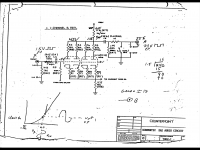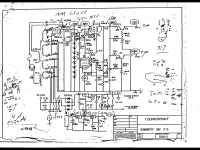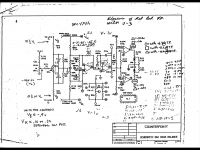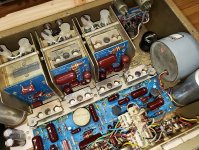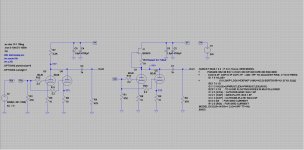I have built several Nuvistor phono stages , very normal two stage like RCA 12ax7 passive eq but with nuvistors. Very good sounding and not very microphonic with Russian nuvistors, much better and more even then American types.
I have read about the Allnic HA3000 and it might be a good idea to dig into CJ head amp, very interesting.
I have read about the Allnic HA3000 and it might be a good idea to dig into CJ head amp, very interesting.
Hi,
I wouldn't. Hfe for the 13 version is only half of that for the MPSA14 so you may end up with too much ripple on the B+.
It's been awhile since I looked into this but IIRC Hfe has a direct effect on how the gyrator performs.
Feel free to correct me if I'm wrong.
Anyhow, you could always give it a try since you have trouble finding it in Spain. Here's it's the other way around, plenty of MPSA14s but zero BF245A, go figure...
If the 13 doesn't perform satisfactorily I can always send you some if you like.
Ciao,
Can I use MPSA13G in place of MPSA14?
I wouldn't. Hfe for the 13 version is only half of that for the MPSA14 so you may end up with too much ripple on the B+.
It's been awhile since I looked into this but IIRC Hfe has a direct effect on how the gyrator performs.
Feel free to correct me if I'm wrong.
Anyhow, you could always give it a try since you have trouble finding it in Spain. Here's it's the other way around, plenty of MPSA14s but zero BF245A, go figure...
If the 13 doesn't perform satisfactorily I can always send you some if you like.
Ciao,
Last edited:
Hi,
thank you Frank for this MC head amp schema! It seems I can get MPSA14 & BF244A:
Partcon Verkkokauppa
Partcon Verkkokauppa
this shop only deliver to Finland but let me know if you need them. I'm going to order them for me so I can add few more for you.
Cheers,
Pete
thank you Frank for this MC head amp schema! It seems I can get MPSA14 & BF244A:
Partcon Verkkokauppa
Partcon Verkkokauppa
this shop only deliver to Finland but let me know if you need them. I'm going to order them for me so I can add few more for you.
Cheers,
Pete
Hi,
No need for matching other than the valves (ECC88 and consorts).
Regarding the power transformers: one is the heater/filament xformer and is full wave bridge rectified and regulated to obtain 12VDC.
Remember each channel uses 2 ECC88s so at 12VDC that would require 365mA per channel.
Although the circuit shows two xformers, in reality it was one xformer with two identical secondary windings of 15VAC (IIRC) which why the windings are put in // and one is using a voltage doubler to obtain ~40VDC.
Ideally you'd like two xformers, one with secondary windings of 15VAC @ 600ma and the other with secondary windings of 30VAC @ 15ma.
This yields two advantages: heater supplies are on separate xformers and the B+ can now use a full wave bridge as well.
I always use EI core types with a static shield that is connected to the common ground.
There are quite probably better regs out there than the ubiquitous 78XX series, LM317 for instance. No idea if it makes a difference sonically though.
According to Mr. Gary Pimm the cap used in the capacitance multiplier (100 microF/25VDC) should be of good quality (film or high Q elco ?).
I have not tried it so I rely on what's been told.
This pre-pre is fully hardwired and uses tag strips for component support. There are just a few of them anyhow and it allows for more lay way to dress the wires.
here is also a metal shield between the PS and the circuit.
Sockets should be high quality ceramic or teflon with good lugs (preferably silver coated), mil spec types and skirted.
I mounted the valves horizontally on a metal L-profile.
Grounding is of the single star point type connected just in front of the metal shield of the xformers.
The 78xxx were bolted to the chassis which doubled as a heatsink, that's why the center tabs are clipped off.
With proper lay-out the should be no hum, no RF and no hiss.
My favourite valves for this headamp are Philips/Siemens E188CC but they're becoming hard to come by at reasonable prices.
Ciao,
No need for matching other than the valves (ECC88 and consorts).
Regarding the power transformers: one is the heater/filament xformer and is full wave bridge rectified and regulated to obtain 12VDC.
Remember each channel uses 2 ECC88s so at 12VDC that would require 365mA per channel.
Although the circuit shows two xformers, in reality it was one xformer with two identical secondary windings of 15VAC (IIRC) which why the windings are put in // and one is using a voltage doubler to obtain ~40VDC.
Ideally you'd like two xformers, one with secondary windings of 15VAC @ 600ma and the other with secondary windings of 30VAC @ 15ma.
This yields two advantages: heater supplies are on separate xformers and the B+ can now use a full wave bridge as well.
I always use EI core types with a static shield that is connected to the common ground.
There are quite probably better regs out there than the ubiquitous 78XX series, LM317 for instance. No idea if it makes a difference sonically though.
According to Mr. Gary Pimm the cap used in the capacitance multiplier (100 microF/25VDC) should be of good quality (film or high Q elco ?).
I have not tried it so I rely on what's been told.
This pre-pre is fully hardwired and uses tag strips for component support. There are just a few of them anyhow and it allows for more lay way to dress the wires.
here is also a metal shield between the PS and the circuit.
Sockets should be high quality ceramic or teflon with good lugs (preferably silver coated), mil spec types and skirted.
I mounted the valves horizontally on a metal L-profile.
Grounding is of the single star point type connected just in front of the metal shield of the xformers.
The 78xxx were bolted to the chassis which doubled as a heatsink, that's why the center tabs are clipped off.
With proper lay-out the should be no hum, no RF and no hiss.
My favourite valves for this headamp are Philips/Siemens E188CC but they're becoming hard to come by at reasonable prices.
Ciao,
CR diodes are actually tiny jFETs with integrated source resistor. I use one as CR for a long tailed pair phase splitter. I am not sure if it has sufficient low noise for using in an MC step-up circuit.Another option would be to pick a constant current diode such as the CR range from Vishay.
.....
There are quite probably better regs out there than the ubiquitous 78XX series, LM317 for instance. No idea if it makes a difference sonically though.
My experience is that replacing the 7812 filament voltage stabilizer to LM317 makes a huge sonic difference.
Hi,
Since the LM317 can work up to 25VDC it may be good idea to replace the 7824 reg. with an LM317 as well.
Ciao,
My experience is that replacing the 7812 filament voltage stabilizer to LM317 makes a huge sonic difference.
Since the LM317 can work up to 25VDC it may be good idea to replace the 7824 reg. with an LM317 as well.
Ciao,
I was researching various tube based MC stages, and came across this thread, and thought I would mention the Counterpoint SA-2, an acquaintance of mine had mentioned owning one. A very interesting design, using fixed biasing, and a neat bias control setup as well!
Attachments
I've been running this simple thing since forever. The tubes were Zaerix branded, made in Russia 6DJ8.
It started out as a quick and dirty experiment, but it's so pleasant I just kept running it until it died: I mistakenly plugged it in an unswitched outlet, so it was running continuously for 10+ years! I swapped in a mckinnie which has a lot less noise, better resolution, but less micro dynamics. And if John Curl (who designed it in the 70's) would look the other way, I'd say I prefer my little thingy.
I found some ex-oscilloscope, HP branded, made by Amperex, 6DJ8 and swapped the thingy back. I'm happy.
It started out as a quick and dirty experiment, but it's so pleasant I just kept running it until it died: I mistakenly plugged it in an unswitched outlet, so it was running continuously for 10+ years! I swapped in a mckinnie which has a lot less noise, better resolution, but less micro dynamics. And if John Curl (who designed it in the 70's) would look the other way, I'd say I prefer my little thingy.
I found some ex-oscilloscope, HP branded, made by Amperex, 6DJ8 and swapped the thingy back. I'm happy.
Attachments
Mounting Nuvistors to reduce microphonics
Nuvistors vary greatly in their tendency to be microphonic from unit-to-unit. The problem is that the character of a microphonic Nuvistor can be very “wirey” and irritating, due to the smaller internal elements resonating at higher frequencies than those in larger tubes.
Ampex used Nuvistors extensively in their last tube recorder, the famous and much-coveted MR-70. It used two tube types throughout: 7895 triodes and 7587 tetrodes. Ampex used a trick however; they mounted the Nuvistors into heavy metal clamps, and I believe these clamps were then isolated from the main chassis by rubber shock isolators. The clamps and rubber “springs” effectively acted as mechanical low-pass filters to keep out vibrations that could excite the internal elements. That’s a bit if a nuisance but perhaps worth trying.
Nuvistors vary greatly in their tendency to be microphonic from unit-to-unit. The problem is that the character of a microphonic Nuvistor can be very “wirey” and irritating, due to the smaller internal elements resonating at higher frequencies than those in larger tubes.
Ampex used Nuvistors extensively in their last tube recorder, the famous and much-coveted MR-70. It used two tube types throughout: 7895 triodes and 7587 tetrodes. Ampex used a trick however; they mounted the Nuvistors into heavy metal clamps, and I believe these clamps were then isolated from the main chassis by rubber shock isolators. The clamps and rubber “springs” effectively acted as mechanical low-pass filters to keep out vibrations that could excite the internal elements. That’s a bit if a nuisance but perhaps worth trying.
Attachments
Post 71 : can somebody please convert the netlist to a schematic ? Thanks
You can. It’s probably an LTSpice schematic file. Just download LTSpice and open the .asc file.
Without the right version of spice you won't see anything.It sounds like you haven’t even tried it. You can open that .asc file and see the schematic right away. You don’t even need to “simulate” anything. It will take you less effort than posting here a few times.
My macspice did not understand the thing.
Displaying the schematics might be a nice gesture to us non-windows people.
Zung gave a probably nice circuit as Christmas gift to the community,
but it is wrapped in a way so that not everybody can enjoy it.
Opening the file for me gives a netlist, on my couch reading device,
and on the office computer also.
I am sure other people would be delighted also. No need to discuss this.
but it is wrapped in a way so that not everybody can enjoy it.
Opening the file for me gives a netlist, on my couch reading device,
and on the office computer also.
I am sure other people would be delighted also. No need to discuss this.
- Status
- This old topic is closed. If you want to reopen this topic, contact a moderator using the "Report Post" button.
- Home
- Amplifiers
- Tubes / Valves
- nuvistor MC step up
